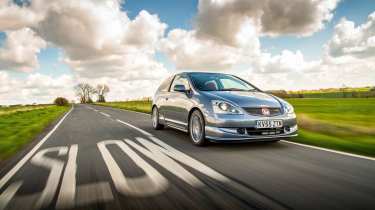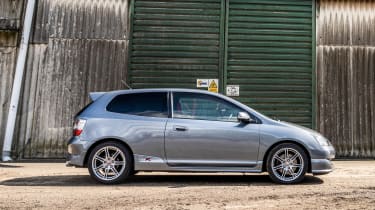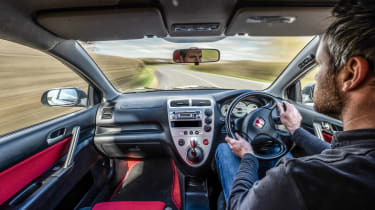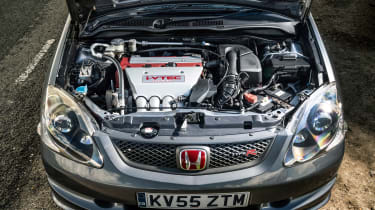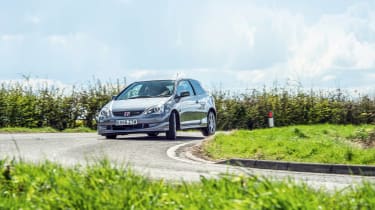Used Honda Civic Type R (EP3, 2001 – 2005) review, specs and buying guide
The early noughties Civic overcame opinion-dividing looks and flawed dynamics to become a legend in its own lifetime. To rev it is to love it
When you can now buy a hot hatch with over 400bhp and spend over £60k in the process it’s hard to remember much simpler times when hot hatches, like the EP3 Honda Civic Type R, made merry with under 200bhp. Conventional wisdom deemed that any more than that and they would really struggle to transmit that power to the road through their front wheels.
Honda's screamer was tantalisingly close with 197bhp – the magic 200 if you preferred your horsepower in PS or hp – but knocked rivals like the Mk4 Golf GTI, Focus ST170 (if not the Focus RS) and Renault Sport Clio 172 into a cocked hat in terms of power output. And Honda would charge you a fiver short of £16k for the privilege. Nigh on 25 years ago it was a big deal. As were performance figures of 0-62mph in 6.6sec and a top speed just shy of 150mph. The EP3 weighed 1204kg, and while hardly a lightweight for its era, the power-to-weight ratio was more than enough to make its 197bhp feel properly rapid even by modern standards.
The EP3 wasn’t the first Civic to be blessed with the Type R treatment – that was the Japanese market only EK9 – but it was the first one sold in the UK which made sense as it was built in the now defunct Honda plant in Swindon. No matter its origins the EP3 became a firm favourite with the hot-hatch community and it’s remained so ever since.
More reviews
At its heart was the manic K20 2-litre four-cylinder whose party piece was the VTEC (Variable Valve Timing and Lift Electronic Control) camshaft arrangement that gave it such a Jekyll and Hyde personality. Below about 6000rpm it felt moderate warm but above that it pulled with real verve until you reached the red section of the rev counter at 8000rpm. The K20 was linked to a slick six-speed manual whose aluminium shifter sprouted from the dash barely a hand’s width from the steering wheel, a perfect complement to the loopy engine.
Honda Civic Type R EP3 in detail
The first Civic Type R (the EK9) was a Japan only creation but in a two-year production run it sold just shy of 16,000 examples in its home market proving that there was definitely room for a new Type R based on the next generation of Civic. It duly arrived in 2001 and closely followed the recipe that had proved so popular previously.
It was based on the seventh-generation Civic shell, but only as a three-door, and while it now presents as a striking monobox design it was dubbed the breadvan by enthusiasts and detractors alike. When compared to later Civics it looks remarkably restrained with diddy (by today’s standards) 17-inch alloys, subtle front and rear spoilers, some sill extensions and a mesh grille.
Under the skin though that three-door shell had been beefed up considerably with a seam welded body. Suspension was by Honda’s tweaked MacPherson struts up front and double wishbones at the rear and the brakes were upgraded from the standard Civic as were springs and dampers. While the underpinnings were decent one area where the EP3 was always criticised was its electric power steering – we’re still chastising systems fitted to today’s machinery and 25 years ago the Civic’s steering was overly vague around the straight ahead. To make the best of the Civic, you just had to accept this failing in its make-up; push through the steering’s initial vagueness and it got much more direct and faithful.
The European models missed out on a couple of goodies that were standard fit on models that were destined to be exported back to the Civic’s home market in Japan. Most crucial of these was the limited-slip differential which meant that deploying all 197bhp could be a frustrating experience and a clumsy right foot could overwhelm the inside front tyre on a tight curve, the Civic leaving a single black line on the exit if you didn’t back out of the throttle – quite extreme when you consider the paltry 145lb ft torque peak.
The diff wasn’t the only item denied to UK and European buyers as the JDM EP3 also received Recaro front seats as well as a more powerful 212bhp version of the K20 engine. This was built in Japan and shipped to the Swindon factory and featured a fully balanced crankshaft assembly, unique intake and exhaust manifolds, more aggressive cams, higher compression pistons, and a lightweight flywheel. UK buyers were also denied the classic Type R white paint.
In 2003, the entire Civic lineup received updates to steering, suspension and the front bumper along with new projector headlights and the addition of the lightweight flywheel to the European version. Celebrating 30 years of Civic production, a 30th Anniversary edition of Civic Type R also was offered in the UK. It added Recaro seats, air conditioning, a leather Momo steering wheel, and red carpet and door panels. Only 300 were made, with 100 each in Nighthawk Black, Satin Silver and Milano Red.
For the 2005 model year, Honda introduced the Civic Type R Premier edition, which was a last hurrah for the EP3. Similar to the 30th Anniversary edition, it also was offered only in the UK. This model featured Recaro Trendline seats in black and red, a Momo steering wheel, red carpet and door panels, and a Type R logo on the front brake calipers. Air conditioning was an option, and the Premier Edition was available exclusively in Milano Red, Nighthawk Black, Cosmic Grey and Satin Silver. By the time the EP3 signed off around 32,800 examples had been built.
What we said
‘Turn the ignition key and the legendary K20 motor is a complete non-event: further evidence that modern cars haven’t become overly refined as is often bemoaned, and that memories can, and do, play tricks. There is no exhaust noise, pops, bangs or cat-superheating theatrics, just the thin, reedy note of a naturally aspirated four-cylinder engine built to Honda’s exacting standards, purring away quietly in the background.
‘Very quickly I am remembering how much I dislike the Type R’s rather unsporting driving position, set high and with the wheel quite flat, and one that not even the lovely black and red cloth-trimmed Recaro bucket seats can salvage. There are no driver modes, no stability control, no buttons at all that need to be pressed to ‘wake up’ or ‘turn down’ the Type R. The whole key here is revs. Lots and lots of revs.
‘The EP3 Civic musters just 145lb ft of torque, with the peak at 5900rpm, pretty much when the second set of cam lobes switches over and things get rather more interesting. While the Type R may be relatively weak at low revs, that’s not to say it has a poor temperament. It may not be very fast low down, but it’s entirely happy pulling smoothly from 2000rpm, even in higher gears, and you can’t help but gain a sense of the engine’s unburstable quality through everything it does. Nevertheless, that’s not what you buy a Type R for: keep your foot squished into the floor mat and hold it there. Once the revs exceed 6000rpm the Type R isn’t all but done like the majority of the modern turbocharged hatches, it’s just getting started.
‘It’s a feral, illicit thrill, one that I’d forgotten was even possible in a vehicle outside of exotica like GT3s. Did Honda really once make engines like this? Engines that it put in vaguely humdrum hatchbacks that weren’t that far removed in looks from those of the brand’s loyal, retirement-age following, and that cost just £15,995. Engines that had a thirst for revs and a simmering, angry, latent energy that’s the match for virtually anything on sale today in its ferocity.’ – Adam Towler, evo 286
What to pay and buying guide
While prices for EP3 Type Rs are still relatively affordable they have firmed up in recent years so if you want one it’s time to start looking in earnest. Prices start at around £4000 for higher mileage cars that will probably need some work doing. There are many machines in the £6-£10k bracket while the very best can command prices getting on for £20k. These latter examples will have very low mileages and be virtually flawless.
As with many Japanese performance cars there are quite a few JDM examples on offer and given their superior hardware buying one of these could be a good move. Just make sure service history and mileage can be verified.
While the EP3 bears a passing resemblance to a shopping hatch its running gear requires a little bit more in the way of maintenance than its run of the mill siblings do so your first stop should be the paperwork. Evidence of regular servicing and preventative maintenance will be the key to EP3 ownership. Regular oil changes are vital, as is keeping an eye on the oil level. Regularly spinning the engine to 8000rpm without enough oil is a recipe for disaster.
The basic engine internals are very tough and heavily modified examples can produce big power without the need for opening the engine up. The most important components are the timing chain and tensioner – some can go at 80k miles with others lasting twice that. Check the paperwork to see if it’s been done recently, if not budget for a replacement. Tappets can get noisy but it’s usually a sign that they require adjustment which is normally done at the 72k service which is a big one. On a test drive make sure there’s a definite step in power when the VTEC kicks in. If not, we’d suggest looking at another car as it could be an expensive fix.
As far as the transmission is concerned, the six-speed manual is durable but second gear synchro can get a bit tired, felt especially when the car is cold. A heavy clutch pedal is a sign that the clutch is on the way out. Gearbox and engine mounts can fail, especially on cars that have been frequently used on track. Fitting an aftermarket limited-slip differential is a very worthwhile modification.
Suspension is fairly trouble free, but as with the majority of older cars it’s quite often the case that dampers and bushes will be getting tired, especially if there’s no mention of replacement components having been fitted in the car’s service history. A steering set up that’s creaking and/or not self-centring or pulling to the right indicates that the rack has failed. Genuine parts are expensive, but refurbished or used parts are a far cheaper option. Installing a front anti-roll bar from a JDM example is a worthwhile upgrade for UK cars, too.
Bodily the EP3 isn’t typically more rust prone than other cars from this era but do check sills and wheelarches (especially the rears on post-facelift cars which added sound deadening that can trap water) as these are the most likely places to find rot. Check the alloys too as they’re also a bit delicate. Watch for exterior trim strips that are coming away from the body and look for worn interior parts too, especially the Recaro seats whose bolsters tend to wear out. If fitted check the air con is cold as failed condensers are common.
Honda Civic Type R EP3 specs
| Engine | In-line 4-cyl, 1998cc |
|---|---|
| Max power | 197bhp @ 7400rpm |
| Max torque | 145lb ft @ 5900rpm |
| Transmission | Six-speed manual, front-wheel drive |
| Tyres | 205/45 VR17 |
| Weight (kerb) | 1204kg |
| Power-to-weight | 166bhp/ton |
| 0-62mph | 6.6sec (claimed) |
| Top speed | 146mph (claimed) |
| Price when new | £15,995 (2001) |
